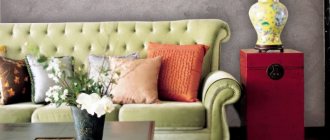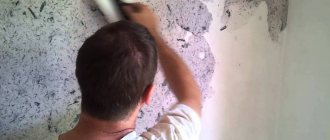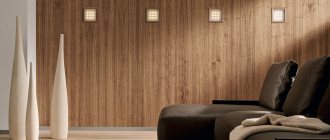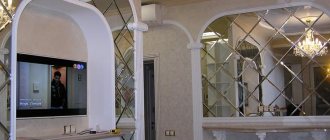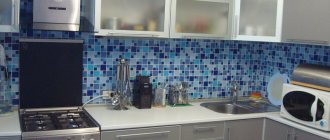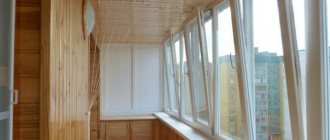Advantages of mosaic
The choice of mosaics is currently very large, so choosing it for the bathroom is not entirely easy. In the case of combining a bathroom with a toilet, it is necessary to improve ergonomics in the equipped areas. In addition to thinking about where and what will be installed - a bathroom, a shower stall, you also need to calculate the points where the lighting will be located, the design of the mirror, hangers, etc.
The entire design should be based on the same color shades or completely contrasting solutions. In terms of texture and color, the selected decor should have something in common with the installed plumbing fixtures (sink, shower stall, bathtub) and ceramic tiles. Most bathrooms have a small area. In such cases, mosaic comes to the rescue, since rooms made with its help are visually enlarged and seem lighter.
Size and shape of mosaic elements
The constituent elements from which mosaic panels are assembled are small in size and therefore convenient for laying out non-flat, curved surfaces, as well as creating real paintings.
An individual mosaic element can have a rectangular shape with sides ranging from 1 to 5 centimeters. The most commonly used mosaic has edges of 2 centimeters. This size is classic.
Often, mosaic elements are assembled into typesetting matrices measuring 30 by 30 centimeters. Such matrices consist of several hundred elements connected by paper or plastic mesh. It is much easier to work with such matrices than with isolated elements.
Mosaic can be not only square in shape. Elements can be rectangular, round or even oval.
The range of mosaic colors is more than huge; it is made from different materials, so you can choose elements with different colors and textures. The only thing that is required is imagination in order to decide on the design of the picture and where to install it.
Mosaic in bathroom design
The combination of tiles and mosaics looks impressive when decorating a bathroom with a shower. This stylistic solution of combining all complex components will give the room harmony and comfort. It is worth paying attention to glass mosaics, which in the bathroom will serve as aesthetic and reliable protection for the walls.
Advantages of glass mosaic:
- provides protection of actively used surfaces from mechanical damage;
- excellent coating that protects walls from bacteria;
- has increased strength;
- water and moisture resistant.
Mosaic wall finishing technology
Laying a mosaic on a wall is more difficult than tiling a wall, and it’s not a matter of the number of fragments. The difficulty lies in preparing a perfectly flat surface, as well as in the peculiarities of forming a pattern on the wall. The cladding itself goes through several stages.
Preparatory work for laying mosaics on the walls
Laying mosaics on a wall begins with finishing the base surface.
Small elements of the coating repeat all the unevenness of the wall, so to obtain a high-quality mosaic, carefully level the surface. The wall should be as smooth as for wallpapering. Features of surface preparation:
- Inspect the surface of the wall, check the strength of the old plaster. If there are blisters on the wall, or if the coating is crumbling, remove it before plastering.
- Level the surface first with a rough cement-sand mortar. At this stage of processing, the presence of depressions or convexities within 2 mm is allowed.
- Check the angle where the walls intersect. If the angle is different from 90 degrees, ensure it by modifying the walls. Otherwise, wedges will appear in the corners, not covered with mosaics, which are difficult to repair.
- Putty the surface and eliminate all unevenness of the wall. The ideal option is to finish the wall with plasterboard sheets.
- Prime the surface to improve moisture resistance and adhesion.
- If necessary, paint the wall the same color as the mosaic.
The quality of the mosaic largely depends on the adhesive solution. There is no universal adhesive for all types of mosaics. The popular adhesive mixture such as Ceresit is not used for fixing glass and smalt mosaics; they require a latex solution. The reason is that the dark glue shines through the translucent fragments and changes their color. To work with paper-based mosaics, choose transparent or white glue; if necessary, give it the desired shade in advance.
Mosaic tile materials
Mosaics are made from glass, natural stone and ceramics. For finishing a bathroom, the latter option is most often used. The ceramic option in combination with plain tiles looks very impressive. You can use its individual elements for patterns. Stone mosaics are made from granite, jasper, marble and other natural stones. This stone is given the required shape by polishing it.
But made from glass, it looks the most original, as it has many color solutions and can be matte, transparent and glossy. Thanks to heat treatment, this finishing material is very durable and safe. It is a wonderful decoration for walls. Not afraid of temperature changes and moisture.
When installing, you need to choose a moisture-resistant glue and then the beauty of the mosaic in the bathroom will delight your household for many years. Unlike ceramic tiles, this material does not have small pores, so it is necessary to use viscous adhesive for vertical surfaces, and elastic adhesive for horizontal ones.
How to prepare the base for laying mosaics?
There are two types of mosaics:
- Ready-made tiles glued to a mesh or paper base. They are convenient to use when you need to create a continuous mosaic canvas with an unobtrusive pattern. The mesh can be cut, giving the fragments the desired shape.
- Fragments that are made by hand. At the same time, the master adjusts individual fragments to their shape, creating his masterpiece. For this finishing, broken tiles or natural (artificial) stone are used.
Whatever type of mosaic is chosen, the surface must be carefully prepared. The plane on which the finishing material will be applied must be flat. Even if there are radii and curvatures, you need to thoroughly clean the surface so that there are no bumps. Unless they were not provided for initially. Because during installation, not every wall defect can be corrected with an adhesive solution. And shortcomings in the preparatory work can affect the outcome of the entire case. Therefore, the surface must be carefully plastered and sanded. If possible, you can line the walls with plasterboard.
Related article: Narrow kitchen design - doing it right!
Naturally, the base must be cleaned of previous coatings. Residues of paint, foreign objects and other contaminants must be removed. Dust must be removed and the surface primed. Otherwise, after a couple of years, the tiles may fall off and the beauty will be ruined.
Facing
Finishing with mosaic cladding is not an easy task. And for those who have never encountered laying tiles on their own, it is better to seek help from specialists.
It is necessary to remember some points when performing work:
- the surface that is planned to be covered with mosaics - concrete, metal, wood - must be perfectly flat;
- Grouting of joints is carried out no earlier than every other day. Epoxy grout is the best option.
Hand selection of mosaic elements
Real masterpieces are created by manually selecting mosaic elements. This method requires a lot of patience and work. After all, you need to not only select the pattern, but also each fragment. This work requires meticulousness and a lot of patience. However, the result is worth it.
There are two ways to process walls:
- 1. In this case, the pattern is first laid out on the floor, after which it is transferred in parts to the wall. 2. Fragments are glued onto thick paper, with the front side facing down. It turns out that a ready-made pattern is transferred to the wall. At the same time, you need to remember that large fragments are inconvenient to glue to the wall. When you need to create a large mosaic image, the picture is simply cut with a knife into easy-to-carry fragments, which are then glued to the wall. This method allows you to create fairly accurate drawings.
Related article: Interior in electric style. Stylish furniture and soft fabrics.
If the paper or mesh base of the mosaic can be cut with a knife, then the tile pieces are given the desired shape using mosaic tongs, which are similar to ordinary wire cutters. If these are not available, you can resort to using a tile cutter or grinder with a diamond blade.

